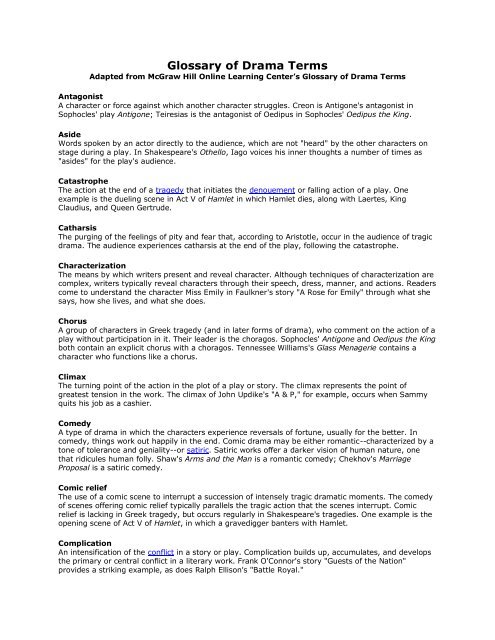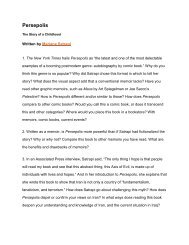You also want an ePaper? Increase the reach of your titles
YUMPU automatically turns print PDFs into web optimized ePapers that Google loves.
ConflictA struggle between opposing forces in a story or play, usually resolved by the end <strong>of</strong> the work. Theconflict may occur within a character as well as between characters. Lady Gregory's one-act play TheRising <strong>of</strong> the Moon exemplifies both types <strong>of</strong> conflict as the Policeman wrestles with his conscience inan inner conflict and confronts an antagonist in the person <strong>of</strong> the ballad singer.ConventionA customary feature <strong>of</strong> a literary work, such as the use <strong>of</strong> a chorus in Greek tragedy, the inclusion <strong>of</strong>an explicit moral in a fable, or the use <strong>of</strong> a particular rhyme scheme in a villanelle. Literaryconventions are defining features <strong>of</strong> particular literary genres, such as novel, short story, ballad,sonnet, and play.DenouementThe resolution <strong>of</strong> the plot <strong>of</strong> a literary work. The denouement <strong>of</strong> Hamlet takes place after thecatastrophe, with the stage littered with corpses. During the denouement Fortinbras makes anentrance and a speech, and Horatio speaks his sweet lines in praise <strong>of</strong> Hamlet.Deus ex machinaA god who resolves the entanglements <strong>of</strong> a play by supernatural intervention. The Latin phrasemeans, literally, "a god from the machine." The phrase refers to the use <strong>of</strong> artificial means to resolvethe plot <strong>of</strong> a play.DialogueThe conversation <strong>of</strong> characters in a literary work. In fiction, dialogue is typically enclosed withinquotation marks. In plays, characters' speech is preceded by their names.DictionThe selection <strong>of</strong> words in a literary work. A work's diction forms one <strong>of</strong> its centrally important literaryelements, as writers use words to convey action, reveal character, imply attitudes, identify themes,and suggest values. We can speak <strong>of</strong> the diction particular to a character, as in Iago's andDesdemona's very different ways <strong>of</strong> speaking in Othello. We can also refer to a poet's diction asrepresented over the body <strong>of</strong> his or her work, as in Donne's or Hughes's diction.<strong>Drama</strong>tic monologueA type <strong>of</strong> poem in which a speaker addresses a silent listener. As readers, we overhear the speaker ina dramatic monologue. Robert Browning's "My Last Duchess" represents the epitome <strong>of</strong> the genre.<strong>Drama</strong>tis personaeLatin for the characters or persons in a play. Included among the dramatis personae <strong>of</strong> Miller's Death<strong>of</strong> a Salesman are Willy Loman, the salesman, his wife Linda, and his sons Biff and Happy.ExpositionThe first stage <strong>of</strong> a fictional or dramatic plot, in which necessary background information is provided.Ibsen's A Doll's House, for instance, begins with a conversation between the two central characters, adialogue that fills the audience in on events that occurred before the action <strong>of</strong> the play begins, butwhich are important in the development <strong>of</strong> its plot.Falling actionIn the plot <strong>of</strong> a story or play, the action following the climax <strong>of</strong> the work that moves it towards itsdenouement or resolution. The falling action <strong>of</strong> Othello begins after Othello realizes that Iago isresponsible for plotting against him by spurring him on to murder his wife, Desdemona.Figurative languageA form <strong>of</strong> language use in which writers and speakers convey something other than the literalmeaning <strong>of</strong> their words. Examples include hyperbole or exaggeration, litotes or understatement, simile
and metaphor, which employ comparison, and synecdoche and metonymy, in which a part <strong>of</strong> a thingstands for the whole.FlashbackAn interruption <strong>of</strong> a work's chronology to describe or present an incident that occurred prior to themain time frame <strong>of</strong> a work's action. Writers use flashbacks to complicate the sense <strong>of</strong> chronology inthe plot <strong>of</strong> their works and to convey the richness <strong>of</strong> the experience <strong>of</strong> human time. Faulkner's story"A Rose for Emily" includes flashbacks.FoilA character who contrasts and parallels the main character in a play or story.ForeshadowingHints <strong>of</strong> what is to come in the action <strong>of</strong> a play or a story.Fourth wallThe imaginary wall <strong>of</strong> the box theater setting, supposedly removed to allow the audience to see theaction. The fourth wall is especially common in modern and contemporary plays such as Hansberry's ARaisin in the Sun, Wasserstein's Tender Offer, and Wilson's Fences.GestureThe physical movement <strong>of</strong> a character during a play. Gesture is used to reveal character, and mayinclude facial expressions as well as movements <strong>of</strong> other parts <strong>of</strong> an actor's body. Sometimes aplaywright will be very explicit about both bodily and facial gestures, providing detailed instructions inthe play's stage directions. Shaw's Arms and the Man includes such stage directions.IronyA contrast or discrepancy between what is said and what is meant or between what happens and whatis expected to happen in life and in literature. In verbal irony, characters say the opposite <strong>of</strong> whatthey mean. In irony <strong>of</strong> circumstance or situation, the opposite <strong>of</strong> what is expected occurs. In dramaticirony, a character speaks in ignorance <strong>of</strong> a situation or event known to the audience or to the othercharacters. Flannery O'Connor's short stories employ all these forms <strong>of</strong> irony, as does Poe's "Cask <strong>of</strong>Amontillado."MonologueA speech by a single character without another character's response.NarratorThe voice and implied speaker <strong>of</strong> a fictional work, to be distinguished from the actual living author. Forexample, the narrator <strong>of</strong> Joyce's "Araby" is not James Joyce himself, but a literary fictional charactercreated expressly to tell the story. Faulkner's "A Rose for Emily" contains a communal narrator,identified only as "we."ParodyA humorous, mocking imitation <strong>of</strong> a literary work, sometimes sarcastic, but <strong>of</strong>ten playful and evenrespectful in its playful imitation. Examples include Bob McKenty's parody <strong>of</strong> Frost's "Dust <strong>of</strong> Snow"and Kenneth Koch's parody <strong>of</strong> Williams's "This is Just to Say."PathosA quality <strong>of</strong> a play's action that stimulates the audience to feel pity for a character. Pathos is alwaysan aspect <strong>of</strong> tragedy, and may be present in comedy as well.PlotThe unified structure <strong>of</strong> incidents in a literary work.
Point <strong>of</strong> viewThe angle <strong>of</strong> vision from which a story is narrated. A work's point <strong>of</strong> view can be: first person, in whichthe narrator is a character or an observer, respectively; objective, in which the narrator knows orappears to know no more than the reader; omniscient, in which the narrator knows everything aboutthe characters; and limited omniscient, which allows the narrator to know some things about thecharacters but not everything.PropsArticles or objects that appear on stage during a play. The Christmas tree in A Doll's House andLaura's collection <strong>of</strong> glass animals in The Glass Menagerie are examples.ProtagonistThe main character <strong>of</strong> a literary work--Hamlet and Othello in the plays named after them, GregorSamsa in Kafka's Metamorphosis, Paul in Lawrence's "Rocking-Horse Winner."RecognitionThe point at which a character understands his or her situation as it really is. Sophocles' Oedipuscomes to this point near the end <strong>of</strong> Oedipus the King; Othello comes to a similar understanding <strong>of</strong> hissituation in Act V <strong>of</strong> Othello.ResolutionThe sorting out or unraveling <strong>of</strong> a plot at the end <strong>of</strong> a play, novel, or story.ReversalThe point at which the action <strong>of</strong> the plot turns in an unexpected direction for the protagonist.Oedipus's and Othello's recognitions are also reversals. They learn what they did not expect to learn.Rising actionA set <strong>of</strong> conflicts and crises that constitute the part <strong>of</strong> a play's or story's plot leading up to the climax.SettingThe time and place <strong>of</strong> a literary work that establish its context. The stories <strong>of</strong> Sandra Cisneros are setin the American southwest in the mid to late 20th century, those <strong>of</strong> James Joyce in Dublin, Ireland inthe early 20th century.SoliloquyA speech in a play that is meant to be heard by the audience but not by other characters on the stage.If there are no other characters present, the soliloquy represents the character thinking aloud.Hamlet's "To be or not to be" speech is an example.Stage directionA playwright's descriptive or interpretive comments that provide readers (and actors) with informationabout the dialogue, setting, and action <strong>of</strong> a play. Modern playwrights, including Ibsen, Shaw, Miller,and Williams tend to include substantial stage directions, while earlier playwrights typically used themmore sparsely, implicitly, or not at all.StagingThe spectacle a play presents in performance, including the position <strong>of</strong> actors on stage, the scenicbackground, the props and costumes, and the lighting and sound effects. Tennessee Williamsdescribes these in his detailed stage directions for The Glass Menagerie and also in his productionnotes for the play.StyleThe way an author chooses words, arranges them in sentences or in lines <strong>of</strong> dialogue or verse, anddevelops ideas and actions with description, imagery, and other literary techniques.
SubplotA subsidiary or subordinate or parallel plot in a play or story that coexists with the main plot. Thestory <strong>of</strong> Rosencrantz and Guildenstern forms a subplot with the overall plot <strong>of</strong> Hamlet.TragedyA type <strong>of</strong> drama in which the characters experience reversals <strong>of</strong> fortune, usually for the worse. Intragedy, catastrophe and suffering await many <strong>of</strong> the characters, especially the hero. Examplesinclude Shakespeare's Othello and Hamlet; Sophocles' Antigone and Oedipus the King, and ArthurMiller's Death <strong>of</strong> a Salesman.Tragic flawA weakness or limitation <strong>of</strong> character, resulting in the fall <strong>of</strong> the tragic hero. Othello's jealousy and tootrusting nature is one example.Tragic heroA privileged, exalted character <strong>of</strong> high repute, who, by virtue <strong>of</strong> a tragic flaw and fate, suffers a fallfrom glory into suffering. Sophocles' Oedipus is an example.














